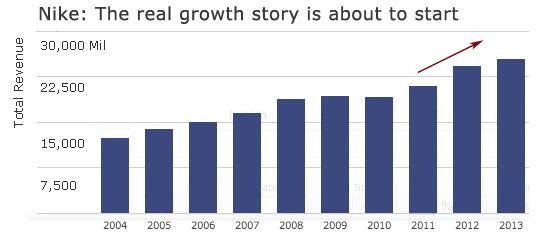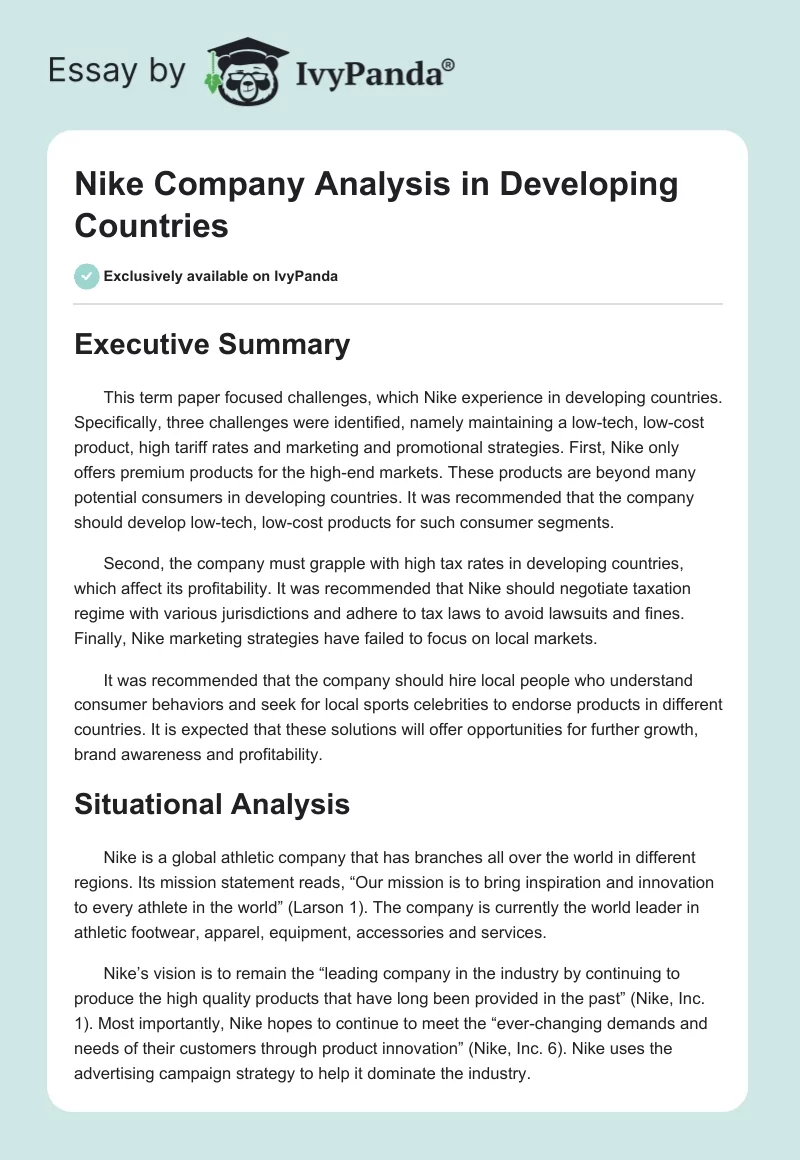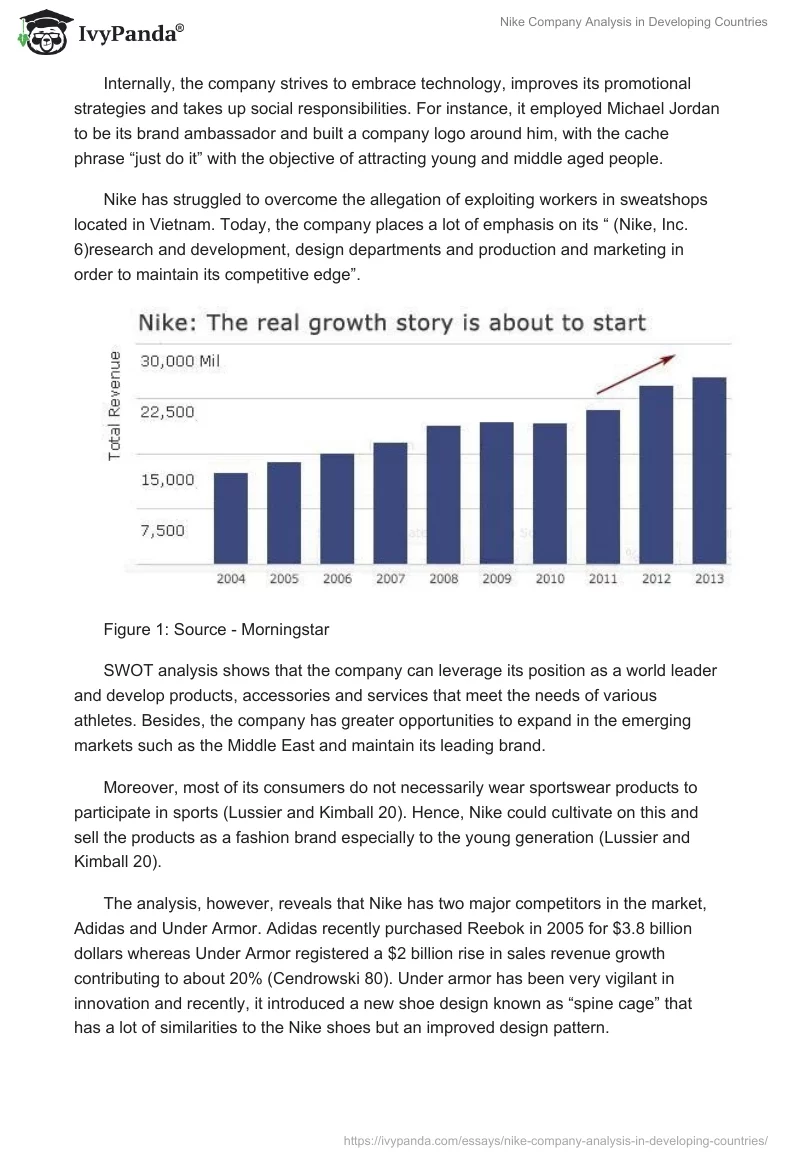Executive Summary
This term paper focused challenges, which Nike experience in developing countries. Specifically, three challenges were identified, namely maintaining a low-tech, low-cost product, high tariff rates and marketing and promotional strategies. First, Nike only offers premium products for the high-end markets. These products are beyond many potential consumers in developing countries. It was recommended that the company should develop low-tech, low-cost products for such consumer segments.
Second, the company must grapple with high tax rates in developing countries, which affect its profitability. It was recommended that Nike should negotiate taxation regime with various jurisdictions and adhere to tax laws to avoid lawsuits and fines. Finally, Nike marketing strategies have failed to focus on local markets.
It was recommended that the company should hire local people who understand consumer behaviors and seek for local sports celebrities to endorse products in different countries. It is expected that these solutions will offer opportunities for further growth, brand awareness and profitability.
Situational Analysis
Nike is a global athletic company that has branches all over the world in different regions. Its mission statement reads, “Our mission is to bring inspiration and innovation to every athlete in the world” (Larson 1). The company is currently the world leader in athletic footwear, apparel, equipment, accessories and services.
Nike’s vision is to remain the “leading company in the industry by continuing to produce the high quality products that have long been provided in the past” (Nike, Inc. 1). Most importantly, Nike hopes to continue to meet the “ever-changing demands and needs of their customers through product innovation” (Nike, Inc. 6). Nike uses the advertising campaign strategy to help it dominate the industry.
Internally, the company strives to embrace technology, improves its promotional strategies and takes up social responsibilities. For instance, it employed Michael Jordan to be its brand ambassador and built a company logo around him, with the cache phrase “just do it” with the objective of attracting young and middle aged people.
Nike has struggled to overcome the allegation of exploiting workers in sweatshops located in Vietnam. Today, the company places a lot of emphasis on its “ (Nike, Inc. 6)research and development, design departments and production and marketing in order to maintain its competitive edge”.

SWOT analysis shows that the company can leverage its position as a world leader and develop products, accessories and services that meet the needs of various athletes. Besides, the company has greater opportunities to expand in the emerging markets such as the Middle East and maintain its leading brand.
Moreover, most of its consumers do not necessarily wear sportswear products to participate in sports (Lussier and Kimball 20). Hence, Nike could cultivate on this and sell the products as a fashion brand especially to the young generation (Lussier and Kimball 20).
The analysis, however, reveals that Nike has two major competitors in the market, Adidas and Under Armor. Adidas recently purchased Reebok in 2005 for $3.8 billion dollars whereas Under Armor registered a $2 billion rise in sales revenue growth contributing to about 20% (Cendrowski 80). Under armor has been very vigilant in innovation and recently, it introduced a new shoe design known as “spine cage” that has a lot of similarities to the Nike shoes but an improved design pattern.
Despite its growth in the international markets, the company faces some obstacles in developing countries such as Dubai. These challenges are mainly associated with the external environments, which Nike may not be able to control to some extent.
Problem Analysis and Description
Nike operations in the developing countries are currently facing many issues and the three problems for review in this research are discussed.
Maintaining a low-tech, low cost product
Nike manufactures high quality products with premium pricing. Hence, it is difficult to stock low tech, low cost products for these markets. In addition, many potential consumers in Dubai and other developing countries have other competing low-cost products to buy other than Nike premium products. For example, there are direct competitors of the company in these developing markets. These competitors have low cost products.
Therefore, it is imperative for Nike avoid the use of products that increase the cost of products faster to cut on costs on making their final products. The company must also look for cheaper ways to cut costs of making its products, for example, searching for cheaper labor and better working conditions for the workers. As noted previously, it had issues in China where there was cheap labor, but bad working conditions that many critics did not support.
As a result, it affected Nike’s business image as the leading company in sports for developing countries. According to the business insider “problems started in 1991 when an activist Jeff Ballinger publishes a report documenting low wages and poor working conditions in Indonesia”. That is, when problems escalated and people began to see the company trying to change and adapt to the mistake it made for the poor working conditions.
Adidas provides products for a better price and it is technically the same thing. Consumers also do not have to choose only one product because of many choices and different products in the country. Many companies are choosing developing countries for global expansion because of the number of rising middle class consumers.
Consequently, consumers have many similar products over the brands that competing. Furthermore, Nike should maintain a competitive price to increase sales in developing countries by reducing costs of making the product to sell more in developing countries.
High tariff rates
Tariff rates in developing countries are extremely high. Therefore, high tariff rates have affected the company’s profitability. For instance, the UAE (Dubai) and other emerging economies have high tariff rates. According to the trade commissioner, the import duties on most goods entering the UAE are 5%. In addition, foreigners cannot own more than 49 percent of the company in several industries in the UAE. Although these tariffs and ownership issues are not barriers to entry, they affect the company’s profitability, revenues and overall growth.
Nike recognizes that a substantial amount of its revenues originate from foreign markets. Current economic and political conditions in developing countries have created unfavorable tax regimes, which have significant impacts. There have been proposals to review foreign tax regimes for the US multinational corporations.
Nevertheless, the company is unable to predict potential changes in foreign countries. These changes affect the income tax rate in the US as well. Moreover, Nike has to consider different statutory tax rates, requirements on deferred tax, changes in tax laws and other liabilities in all jurisdictions that could impacts its profitability.
The company performs several intercompany transactions with its distributors and subsidiaries related to tax issues in various jurisdictions. These are complex transactions. Nevertheless, Nike believes that they are accurate and capture economic realities on the ground. However, when local tax authorities scrutinize such transactions and detect any anomalies, they can adverse affect incomes, particularly in countries with high different tax rates (Nike, Inc. 7).
Nike believes that its tax audits and provisions are adequate. However, results from tax audits and other disputes could be different from its normal provisions and accruals. Any audit disputes could result in major financial implications for the periods affected.
Change of marketing strategy
Based on Nike’s under performance in many foreign markets, it is likely that its marketing strategy in different regions may not include teams or individuals native to those regions and this has resulted into a crisis (Deng 102). Nike should employee locals for its marketing departments for various countries in which it operates because people from those countries understand consumer behaviors and how they make choices on products.
Consequently, the company must review its marketing strategies to target locals based upon the best needs that fit that specific country. Moreover, the company relies on expensive, sports celebrities to endorse its products.
Nike acknowledges its relationships with “professional athletes, sports teams, and leagues to develop, evaluate and promote its products, as well as establish product authenticity with consumers” (Nike, Inc. 6). It is possible that Nike has not found suitable endorsers in certain developing countries.
Consequently, its marketing activities have been adversely affected in such regions. Moreover, any changes with the current endorsers could result in losses to the company. There are also possibilities that its promotional associates may use products in manners that hurt the reputation of the brand and its image. Such actions could adversely affect the company’s sales, operations and revenues from its subsidiaries.
In some instances, Nike has cited poor performances by product endorsers or inability to identify the most promising athletes to promote its products globally. Moreover, Nike has failed to get endorsement at fair rates that make economic sense. All these expensive endorsements and other related challenges have affected the company’s sales, revenue growth and profitability as well as shareholders’ returns.
Solutions, Evaluations and Recommendations
Three critical challenges affecting Nike in developing economies have been identified as maintaining a low-tech, low cost product, high tariff rates, and marketing and promotional strategies. Consequently, the company requires effective solutions to overcome these challenges. However, it is imperative to note that Nike may find it difficult to control tax regimes in different jurisdictions because these are external conditions resulting from governments’ actions.
Although there are large numbers of rising middle class in developing countries such as the UAE, Nike apparels are exclusively expensive and meant for high-end consumers. Therefore, Nike should make specific products that will appeal to its targets markets in developing countries. The company must also note that many consumers of its products are not necessarily sports personalities.
This is an opportunity for Nike to introduce ‘streetwear’ for such consumers. It would drive the brand sales and image. These products do not necessarily have to incorporate high-tech designs and expensive fabrics meant for athletes. The approach is likely to be successful because of popularity of Nike products despite their premium pricing.
Tariff rates have affected the company’s earnings and profitability. For instance, in the UAE, the company can only own 49 percent stake in the investment. In addition, the UAE commercial law favors agents from foreign investors. It would be difficult for Nike to get favorable taxation systems in developing countries because of red tape in policy change. Nevertheless, the company must stick to the law in order to avoid expensive lawsuits and subsequent fines associated with failures to adhere to tax regimes.
Nike must review its marketing and promotional team in different countries. The marketing department requires a different staff set up to deal with the changing times. Currently, Adidas has embarked on fierce marketing campaigns to outdo Nike. A quality staff engagement relates to the qualitative adjustment in the marketing performance. New marketing officials will come up with a different approach in addressing the related market conditions that are irrelevant now.
The head of the department should be encouraged to understand the need to outdo the company’s competitors such as Adidas in retaining the market leader position (Bergen 49). A different marketing approach will determine the rate at which Nike products are selling under normal marketing operations.
The use of print media is currently not doing the company well. They should reconsider a qualitative approach in addressing the television media and event promotions that will improve the reception that the company’s products get in the market. The change in the marketing strategies will facilitate the making of an evaluation that is useful in addressing the relevant adjustment in meeting the right market specifications.
Nike must conduct market research in developing countries to understand advertisement messages that appeal to consumers. Nike’s quality solution to the completion crisis relates to their understanding of the market functioning as per the right market attributes that play an important role in creating more customer loyalty.
The right research relates to the fundamental marketing principles that improve the general aspects of the marketing methodology with respect to the existing issues that advance the relevant understanding of the marketing mix (Seymour 50). The deep issues are a part of the market outreach programs determine through the evaluation of the existing conditions in dealing with deep market segments as part of the right development of the marketing strategies.
The changed approach in the marketing strategy requires a consideration of the benefits that it brings about. The news marketing campaigns should not have a high cost to the company.
Unmatchable advertising costs interfere with the rate of gains in paying back to the entrepreneur (Gromer 50). The choice of the marketing channels should have matching revenue. It is important for the marketing department to come up with a cost and benefit analysis that appreciates the role played by each of the different methodologies in increasing the sales volumes.
Implementation Plan
The relevant stakeholders in the marketing of the company’s products are engaged in determining the change in plan. Each of the players in the success of the marketing strategy requires an attention so that they can give their opinions as per their experiences (Samuels 20).
The parties to the new marketing strategy believe in the success of their operations with the objective of increasing the company’s profitability. Different responsibilities and accountability levels are allocated to each of the related parties with the goal of executing the relevant work formula.
Nike will require the following resources to implement these solutions.
Staff: Hire local staff for marketing departments, if not available.
Training: The company will train its marketing departments to understand local consumer behaviors in order to develop marketing tools specific to noted behaviors.
Assessment tools: Nike will develop market survey instruments to assess impacts of marketing strategies on consumer awareness and sales. In addition, assessment tools will be used to assess change in knowledge and skills in marketing departments.
Funds: Funds and other resources for additional staff, product endorsers, assessment tools, technologies, external adult trainers and training will be required to support the implementation of new solutions and strategies.
Success Metrics
The success of the new marketing operations has a direct proportion to the incremental sales volume. The change in the sales figure is compared to the incremental marketing cost on the income statement. Success for Nike is evident in the profitability levels that are an indication of the improved performance (Bergen 52).
Changes in profit margins determine the immediate effect regarding the new approaches with respect to the implemented plan. Ratio analysis for Nike evaluates the rate at which the business is capable of dealing with the completion from Adidas, which is a competitor in the same industry.
Increased product awareness and sales will also reflect effectiveness of the new marketing and promotional strategies.
The company will note increased changes in tax regime if negotiations are successful. In addition, adherence to tax laws will eliminate potential lawsuits and fines. Nike must review these solutions every quarter based on the financial calendar.
Works Cited
Bergen, J. “Sneak Peek.” 64.4 (2012): 47-54. Print.
Cendrowski, S. “Nike’s New Marketing Mojo.” Fortune 165.3 (2012): 80-88. Print.
Deng, Tianbai. ““Just done it”- Nikes new advertising plan facing global economic crisis.” International Journal of Business and Management 4.3 (2009): 102-105. Print.
Gromer, C. “Inside Nike’s Secret Sports Lab.” Popular Mechanics 178.7 (n.d): 44-51. Print.
Larson, D. “Global Brand Management — Nike’s Global Brand.” ISM Journal of International Business 1.3 (2011): 1-14. Print.
Lussier, Robert and David Kimball. Applied Sport Management Skills. Massachusetts: Human Kinetics, 2012. Print.
Nike, Inc. FORM 10-K Annual Report for the Period Ending 05/31/13. Beaverton, OR: EDGAR Online, Inc, 2013. Print.
—. FORM 10-K Annual Report for the Period Ending 05/31/14. Beaverton, OR: EDGAR Online, Inc, 2014. Print.
Samuels, A. “Maybe it Is the Shoes.” 148.20 (n.d): 14-20. Print.
Seymour, R. “Sporting design goes trendy.” 1.424 (2005): 50-60. Print.


